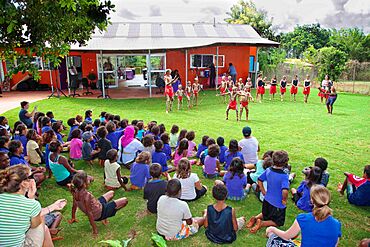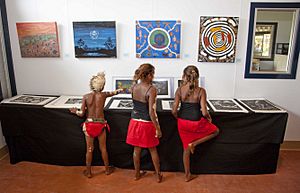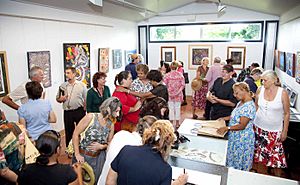Hope Vale, Queensland facts for kids
Quick facts for kids Hope ValeQueensland |
|||||||||||||||
|---|---|---|---|---|---|---|---|---|---|---|---|---|---|---|---|

Hope Vale, 2009
|
|||||||||||||||
| Population | 1,004 (2021 census) | ||||||||||||||
| • Density | 0.48070/km2 (1.2450/sq mi) | ||||||||||||||
| Postcode(s) | 4895 | ||||||||||||||
| Area | 2,088.6 km2 (806.4 sq mi) | ||||||||||||||
| Time zone | AEST (UTC+10:00) | ||||||||||||||
| Location |
|
||||||||||||||
| LGA(s) |
|
||||||||||||||
| State electorate(s) | Cook | ||||||||||||||
| Federal Division(s) | Leichhardt | ||||||||||||||
|
|||||||||||||||
Hope Vale, also known as Hopevale, is a town in Queensland, Australia. It is a special Aboriginal community located on the coast. In 2021, about 1,004 people lived there. Hope Vale is part of the Aboriginal Shire of Hope Vale.
Contents
Where is Hope Vale Located?
Hope Vale is on the Cape York Peninsula. It is about 46 kilometres (29 miles) northwest of Cooktown by road. The town is also close to Rinyirru National Park.
A Look Back: Hope Vale's History
Early Mission Days
In the late 1800s, a missionary named Johann Flierl started two missions nearby. One was the Elim Aboriginal Mission in 1895. The other was the Cape Bedford Mission in 1886. These missions were set up to help Aboriginal people.
World War II and Relocation
During World War II, there were worries about the safety of the Aboriginal people. In May 1942, the entire community of 286 people was moved. They were sent to different places in the south, like Woorabinda. Many people faced very tough times during this move. The German missionaries were also sent to special camps.
Rebuilding Hope Vale
Hope Vale was re-established as a mission in September 1949. Aboriginal people from the old missions came back to live there. The first families returned home in 1950. The community was later moved inland to its current spot. This happened because the old location didn't have enough water. Today, Hope Vale is one of the oldest continuing mission communities in North Queensland.
Languages Spoken in Hope Vale
Guugu Yimithirr Language
One important language spoken in Hope Vale is Guugu Yimithirr. This is an Australian Aboriginal language. It is also spoken in the nearby Cooktown area. The language region includes the Aboriginal Shire of Hope Vale.
Many Languages, One Community
Hope Vale is home to several different clan groups. Most people speak Guugu Yimithirr. They also speak other related Aboriginal languages. English is also commonly spoken in the community.
Education and Learning
Local School
Hope Vale has a primary school campus. It is part of the Cape York Aboriginal Australian Academy. Students from Preparation (like kindergarten) to Grade 6 attend this school.
Learning Beyond Primary School
There isn't a high school directly in Hope Vale. Older students usually go to the nearest secondary school. This school is Cooktown State School in Cooktown.
Indigenous Knowledge Centre
On July 21, 2008, the Hope Vale community opened a special place. It's called the Indigenous Knowledge and Technology Centre. This centre is like a library. It also offers training and public internet access. It helps people learn and connect.
Hope Vale's Modern Culture
Choral Singing Tradition
The Hope Vale community has a strong tradition of choral singing. This tradition started after the community was moved to Woorabinda during the war. The Hope Vale choir has performed at the Queensland Music Festival many times. They performed in 2005, 2007, and 2009.
Notable People from Hope Vale
Hope Vale has been home to several well-known Australians:
- Eric Deeral (1932–2012) was an important politician. He was one of the first Aboriginal people elected to an Australian parliament.
- Matt Bowen (born 1982) is a famous Queensland rugby league player.
- Noel Pearson (born 1965) is a lawyer and activist. He works to improve life for Aboriginal people.
Images for kids







